Toño Mèndez
"One Man and His Drone"
Ayamonte has many wonderful colourful corners and people. And this evening Monday 2nd of March 2015 I meet one of Ayamonte’s characters who does a lot of work in promoting Ayamonte both over the air and in the air (you will see what I mean in a while).
M: Hi Toño, good to see you again and thank you for taking the time out to do this interview.
T: No problem, as long as interview is not in English because I am bit rusty (followed by a hearty laugh).
M: A lot of people know you for the aerial photography you do of Ayamonte but you work in the local radio station as a sound and image producer.
T: Yes, I did a lot more work on image when Guadiana tv was open and now for municipal radio station I do technical production and production for live radio programmes.
M: Talking about production and film, I know that you have been working on recovering 8mm film and digitalising old footage of Ayamonte.
T: That is a personal labour of love and yes it’s a project that I have been working on for over 12 years now. There is a lot of film out there and it would be a shame for it to be lost. Currently there must be over 90 hours that I have recovered from old film and film shot on the old Tomavistas Super 8 cameras. Over the years I have spent almost €20,000 in this project and now many people give me films to recover. A lot of the material is from Ayamonte at the end of the 20th Century.
M: You must see a lot of changes in Ayamonte from then to now.
T: Like all places, with time comes change, back then the fishing industry and the river Guadiana was the centre of everything.

M: You live in the Barriada of Isla Canela, an area of Ayamonte that seems to have held on to that fishing village feel.
T: Yes, Ayamonte over the years as a town seems to have turned its back on the River Guadiana, a mistake in my opinion. Another one of my projects is “Guadiana la Vida de Un Rio” Guadiana the life of a River. The canning industry has moved away from the river but I try to capture the images along that river to show the people nowadays that it has a lot to offer not only to the local people but also to the people living outside Ayamonte. There are loads of people who are working on plans to bring the river very much back in to the Ayamonte town from architects to politicians, we are all looking at ways to return the river to its rightful position as a Vital Artery of the Village. And we will succeed!
M: I have seen many of the photos you have taken of the river and they are spectacular. I have got to admit I have a weakness for aerial photos.
T: Yes, with the help of the drone you can really get some great shots of the Guadiana and Ayamonte Town.
M: I recall seeing a video of you flying over the marshlands and a flock of flamingos taking to flight.
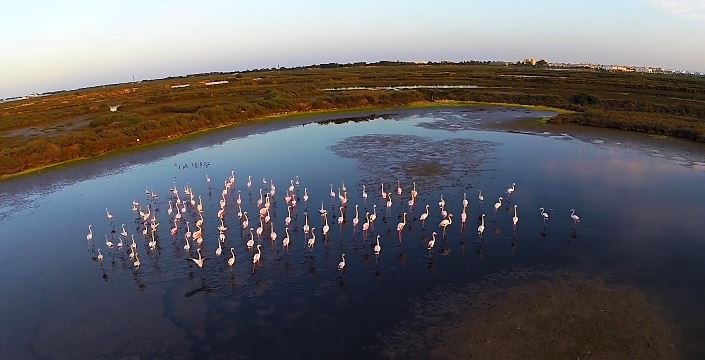
T: Yes, that was almost a year ago. When I bought the drone I always wanted to record that image. You see, flamingos fly into this area around February and leave in about May. I was flying near the tidal mill in Pozo Del Camino and came across the flock of flamingos. They were just within range and luckily I could record and return. That was one of the first videos I recorded with the drone.
M: Your vimeo page has some great videos of the beach and Ayamonte town.
T: Always trying to improve and learn more, I will always do everything I can to get the image and feel of Ayamonte out there. It is something I am very proud of.
M: You were born here in Ayamonte, have you ever lived anywhere else?
T: I made my first appearance in Ayamonte on New Year’s Eve 1969, didn’t even give my mother time to eat the grapes so to speak. I have lived in Ayamonte most of my life and only was away while I studied in Seville but Ayamonte is my home and I am happy and content here and the odd time I do get away I am glad to get back to Ayamonte.
M: I know you also do video clips for music groups but you are a very much sought after DJ, how long have you been doing that.
T: I started spinning in the 80’s with my vinyls but it has evolved immensely since then, you could say it has been revolutionised or industrialised. Similar to the photography it has changed in the last 30 years.
M: Your producer background sets you apart as you mix music and video clips in your sets.
T: Yes, it is called AV SET. Back in the 80’s we had MTV and I think this format is capturing the feel of how we related to music back then. It is also nice to be able to put images to music that originally never had a video clip in the first place.
M: Thanks so much for your time and insight and I look forward to seeing and hearing you work for a long time to come.
T: A pleasure, as long as I am enjoying it, I will keep doing it.
For those of you who want to see Toño's work check out his video website https://vimeo.com/tognomendez or his facebook page https://www.facebook.com/tono.mendez.9
María Rosa Gómez
"A Thousand Colours & A Thousand Corners of Ayamonte"
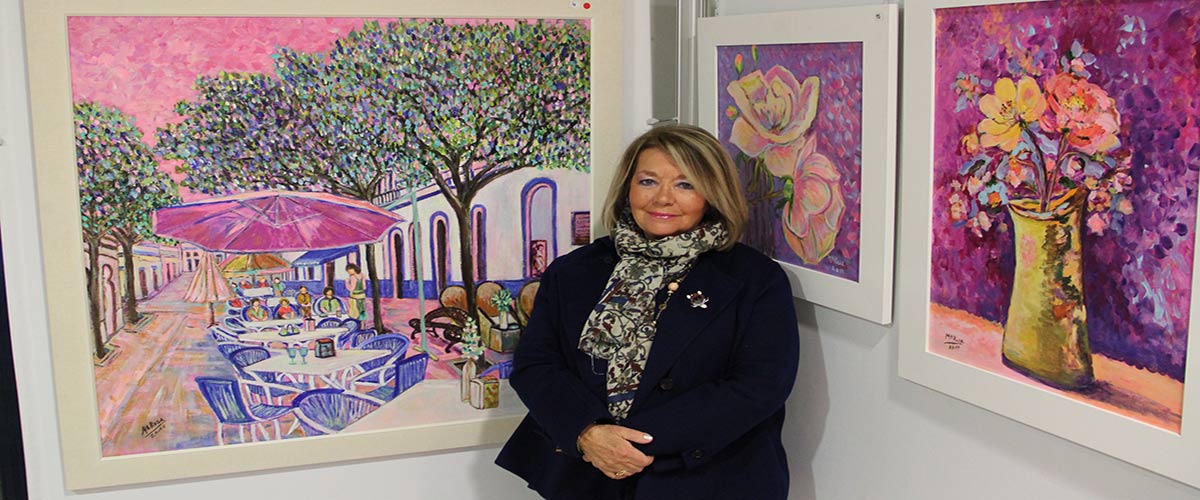
María Rosa Gómez was one of the instigators for the now annual event called Paseo por el Arte in Ayamonte and it was there two years ago I saw some of her paintings and made a mental note to make sure to interview her at some stage for Infoayamonte. Today 25th February 2015 in Vila Real de Santo Antonio I finally get to round to viewing more of her art and to introduce her via this interview to the Infoayamonte readers.
M: Hi Rosa, thanks for meeting me.
R: My pleasure, you should have come to the opening night as there was wine and tapas.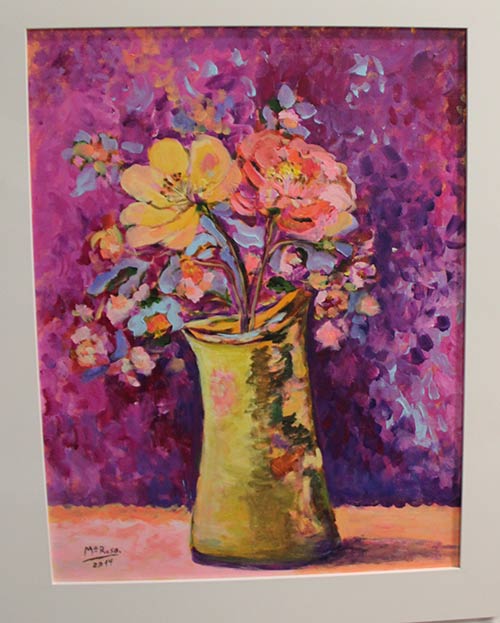
M: Would have loved to but I have been pretty busy with work.
R: Next time I will give you plenty of notice so no excuses.
M: That’s a deal, so tell me Rosa how long have you been painting for?
R: I have always loved painting but I think the first painting I framed was when I was 16 years old more or less.
M: And what was that painting of?
R: Of the marshlands around Ayamonte. There is nothing better than capturing the light and atmosphere of the corners of Ayamonte.
M: Your paintings fall into Impressionist painting category as you said before you like Degas, Renoir and Monet but did you go to art school.
R: Never got the chance to go to art school. I am self-taught and many of my childhood friends also have a love of art and we still meet up and paint together. I like to think that I have a good sense for colours and am not afraid to mix up colours to get what I have in my head onto canvas.
M: So you have been painting a good few years, yet this is your first exhibition.
R: Working as a nurse and a full-time mother to my children (Rosa and Juan Jose) meant that painting had to take a back seat for a while and it’s only now that I am retired that I can dedicate the time my painting requires. Previously I have been involved in collective art exhibitions and of course the Paseo por el Arte in Ayamonte but it wasn’t until a good friend of mine finally encouraged me to do my own exhibition and here it is Mil Colores (A thousand colours).
M: So how has this exhibition gone for you so far?
R: When it opened many of my close friends and fellow artists came to the inauguration, you could imagine how proud I felt and feel. There is nothing better that feeling the warmth and appraisal from friends for something that is very much part of my life.
M: And why call it Mil Colores?
R: The paintings in this exhibition have a thousand colours, all mixed up, not following rules but by feeling.
M: You mentioned Paseo por el Arte and last year it was a huge success, the streets were packed, I even heard people were fighting to buy your paintings (I say part joking).
R: A number of artists including myself got together a few years ago to try and bring art back to the centre of Ayamonte and from this Paseo por el Arte was born. Last year was very good and I sold a few paintings and the episode I think you are referring to is of a painting of Plaza de la Lota. It sold quickly and another person wanted to buy it too, in the end she commissioned me to paint a particular scene for her so in the end everyone was happy.
M: So your first exhibition is here in Vila Real de Santo Antonio so I can call you an international artist right from the start.
R: International? Well, we are on the other side of the Guadiana River in Portugal (she says with a laugh). You know Michael, I live for painting and can get completely sucked in when painting so much so that I lose track of time and even forget to eat. That someone wants to come and view my work makes me proud.
M: So where next from here?
R: A good friend, Jose Luis Rua Nacher, asked me to do a painting based on a poem he had written. I have just completed it and he was delighted, he is going to auction off the painting for charity. We, that is a few female artists, are looking at setting up an exhibition this summer. I will let you and your readers know closer to the date once everything has been confirmed.
M: Thanks Rosa for your time and I look forward to seeing more.
Many months ago I was in the Casa Grande in Ayamonte showing one of my in-laws around when he commented on a painting by Emilio Borrego. From there the seed was sown to do this interview.
Now most people know Emilio Ferrer Borrego from the electrical stores (Ferrer) that they have both in town and in the new industrial estate, but not everyone knows how prolific and well regarded he is amongst the consecrated artists in Ayamonte. And as his shop is the best place to catch Emilio that’s where this interview took place.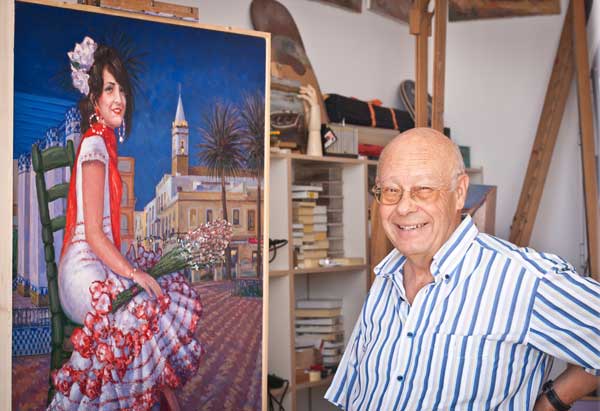
M: First of all Emilio I would like to congratulate you on the painting for this year’s Angustias Festival. I know it is being officially presented tomorrow in the Casa Grande but I was lucky enough to see a pre-release and I must say it’s a lovely portrait of the Plaza Laguna during the festivals.
E: Thank you, what you may not know is that the young lady in the painting is my niece Amanda.
M: No, I didn’t know that but now that you mention it she looks a little like her sister Mariá the chess champion. How did you end up painting the poster for the Angustias Festival?
E: The councillor for Culture, Francisco Blasquez, approached me three months ago and asked me to do it and I had this idea of including Amanda and the Plaza Laguna. What you see today is almost two months hard work.
M: The colours are fantastic and what are those flowers she is holding?
E: The time of day was important to me just as the sun is going down, the sky is that lovely blue and the bell tower in the Angustias church is lit up. The flowers she is holding are Nardos (Spikenard).
M: Am I right in saying that this is not the first time you have painted the poster for the Angustias Festival?
E: Yes, indeed I did one in 1978, another in 1994 and this one now in 2012.
M: It must be an honour to paint the main poster for your home town on so many occasions.
E: The Virgin Of Angustias is the Patron Saint of my home town, so yes, it is an honour and I’ll tell you another thing that not many people know: In 1980, I was given a very special frame which dates back to 1929 and I did a painting of the Vírgin of Angustias to fit that frame and it hangs proudly over my bed.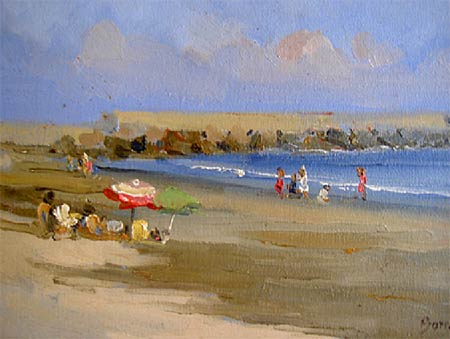
M: Your painting of Semana Santa is one of the most favoured also.
E: The 1997 painting of “El Cristo de la Buena Muerte” going up Felipe Hidalgo Street has received a lot of praise and in 2005 I painted El Salvador.
M: I am always curious as to how people start painting some start later on in life but I heard you started painting at a very young age.
E: Painting was a little later but I started drawing when I was about four or so. You see, my brother Juan who was 13 years older than me painted and I wanted to be like him when I was a child. He actually kept my drawings and when I was older he handed them back to me saying that he always knew I would turn out to be a good artist.
M: So it was your brother Juan that influenced you and brought you into the world of painting.
E: Not only Juan but also my mother and father they were both good drawers. Then Juan who was a graphic artist left to work in Madrid for Aguilar and carved a name for himself drawing the famous bullfighting posters.
M: Juan left for Madrid when you were eight so did you stop drawing for a while?
E: No, not really. Painting is a form of enjoyment for me and even if I don’t have a brush in my hand I paint my pictures in my mind every day and I can’t see that changing ever. When Juan left, I started to develop my own style and I remember my school teacher Don Antonio Moreno Diaz saying to me after we were asked in class to draw “Emilio you are going to be a painter”. Of course all my work then was in pencil and it wasn’t until I was 16 or so that I painted my first Oleo.
M: Can you remember what it was you painted and do you still have that painting?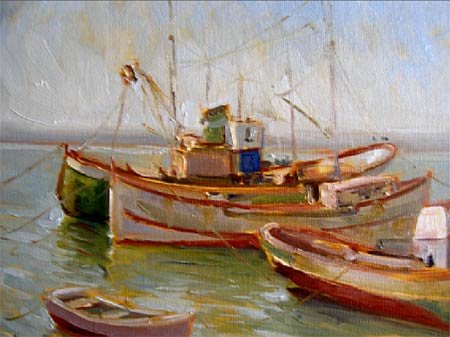
E: It was a forest in the Swiss Alps covered in snow, nothing spectacular but it did attract attention and I still have it. I rarely sell my paintings as I do them for my enjoyment and if people can enjoy them with me even better.
M: I have seen some of your exhibitions and although your paintings are rarely for sale, you have sold some paintings. Can you tell me what was the first painting you sold?
E: You are making me recall some funny things, I remember the first painting I sold was of Plaza Laguna and I got 1000 pesetas for it which would be a little over six euros in today’s money. And it took a while to get paid for that painting.
M: I know very little about art but the more I learn the less I seem to know, how would you describe your art?
E: Landscapes are something I enjoy doing and I would describe what I paint as figurative and natural and I would class myself as an impressionist painter. I strive to find reality in my paintings.
M: About three maybe four years ago you showed me a mixture of green paint and asked me how longs it took to make, it was a trick question.
E: Yes, I remember and no one was going to guess 40 years, that’s what it took me to get the green I have been looking for. It took me 40 years to be happy with the greens on my palette. People know me more for my blues; all of my paintings have blue in them in some way or another.
M: Why is that?
E: The light here is very special and of course the sky is almost always blue and this blue is reflected in everything. If you look very closely in my paintings you will see that many of my colours have a blue base.
M: I live in Ayamonte myself and one of your paintings which I saw recently is a painting done from the hills behind my house towards the marshlands and it was my brother in law who asked about it.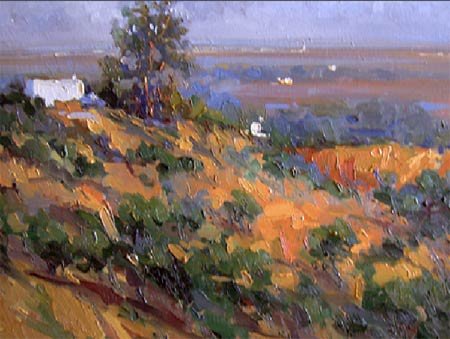
E: The marshlands are great to paint and I know exactly where you are talking about. Many a splendid afternoon I have spent painting the marshlands and working on the layered transparencies of all the colours that the afternoon sun can leave on your retina.
M: Where can our readers see more of your art?
E: There are a few paintings in the Casa Grande and when I do exhibitions although I don’t have any planned soon but maybe the best place to see my paintings is on this web page called
http://www.emilioborrego.com/
M: Thank you for your time and I am sure our readers will enjoy the insight into the painter Emilio Ferrer Borrego.
E: A pleasure and I will have to brush up on my English to read this on your infoayamonte site.
The Costa de la Luz as its name suggests “The Coast of Light” has always been a huge attraction to photographers and artists who simply fall in love with the light and clarity that is part and parcel of this area.
 Ayamonte has charmed its fair share of artists over the last century and Sorrolla’s “La pesca de atún”, tuna fishing, depicting sailors landing tuna on the banks of the Guadiana River, is probably one of the best known paintings to have come out of this border town. It seems only fitting that we talk to a son of a sailor and one of the most famous present day artists in Ayamonte, Rafael Oliva.
Ayamonte has charmed its fair share of artists over the last century and Sorrolla’s “La pesca de atún”, tuna fishing, depicting sailors landing tuna on the banks of the Guadiana River, is probably one of the best known paintings to have come out of this border town. It seems only fitting that we talk to a son of a sailor and one of the most famous present day artists in Ayamonte, Rafael Oliva.
M: Many of our readers will already know your work, with some of your paintings on show in Parador Hotel Ayamonte and of course the paintings in Ayamonte town hall but few will know the beginnings of Rafael Oliva. When did you start painting?
R: I have always painted and in school “La Merced” I used to draw on the blackboard, using coloured chalk, whatever the teacher asked me, I was pretty good at writing and liked using gothic style letters.
M: You left school at an early age?
R: Like a lot of people at the time, I left school at the age of 12 and had my first job running errands for Ayamonte Football Club and I helped the team physiotherapist. Ayamonte FC were in the provincial league and I remember going to away matches in Bollullos, which is what? some 90 kilometres away, but I felt I was travelling the width of Spain. Sure I even wanted the players to get injured so I could run on the pitch following the physio with the first aid box to impress the women in the crowd.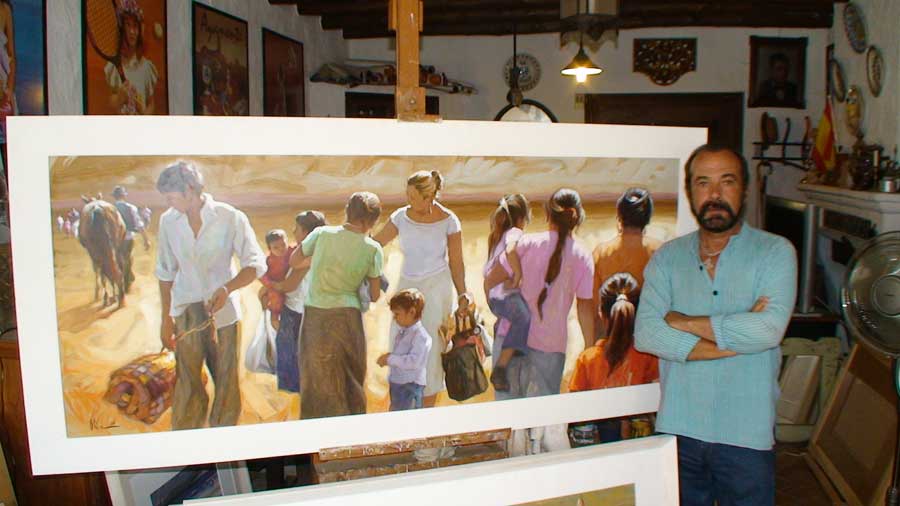
M: No art college for you then, did you still paint while you were working for Ayamonte FC?
R: That’s right, I taught myself and learned from my mistakes. One of the Directors of Ayamonte FC, Juan Moreno offered me a job in his clothes shop in Ayamonte and I jumped at the opportunity. It meant that I would finish at 8pm rather than after 11 in the club and I could now go to the cinema, my other great passion.
M: You have done posters for some of the local film festivals?
R: Yes, although it is something quite different from my normal work. I did the poster for the XVII Iberoamerican Film Festival in Huelva in 1991 and Islantilla Film Festival in 2003. I am huge cinema fan, so much so that once I took a bus to Seville to see the film “Ryan’s daughter” starring Robert Mitchum and Sarah Miles and had to stay the night in a hostel before getting the bus back in the morning.
M: I always meet you walking around in Ayamonte but I have never seen you driving, Is there any truth that you don’t have a driving licence although you own a beautiful vintage car.
R: Never got a driving license and my good wife drives me everywhere as well as that it ia always nice to take a stroll through Ayamonte and not need a car.
M: It wasn’t until 1975 that you had your first major exhibition in Madrid, what was Rafael Oliva doing before that?
R: I worked in the shop for 15 years and although I was head of the menswear section many people came into the shop to order pieces of art. Just around the corner from the shop I had a small studio where I would go after the shop was closed to paint and exhibit my paintings. It was a local priest who let me use the studio to paint. It was my own clients who eventually pushed me out of the clothes shop telling me I should dedicate all of my time to art. My wife who was pregnant at the time with my daughter was fully behind me so I packed 7 of my paintings and took the train to Madrid, not really knowing what to expect.
M: Your first exhibition in Madrid was in Galeria Verona on Calle Bernardo Nº18 and you sold 19 of the 23 paintings that unbelievable for a relatively unknown Huelva artist at the time.
R: A small town painter in Madrid city with a young pregnant wife at home, I knocked on every gallery door and it was José Luis Mazuelo from Galeria Verona who gave me the opportunity. As luck would have it, a space which was reserved for a painter from Valencia came available and my first major exhibition opened a month later.
M: So even an established artist like you needs a bit of luck?
R: I had lots of luck and a meeting with the late Rocio Jurado, her husband at the time Pedro Carrasco and her brother Amador in the Palace Hotel in Madrid helped me get recognised.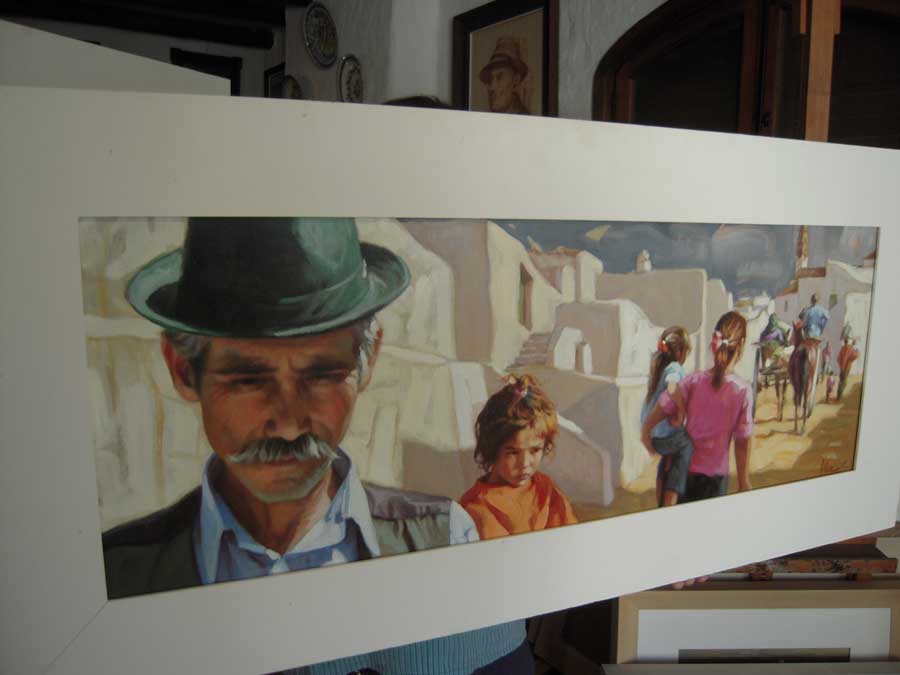
M: A lot of things have changed since then and talking about money is never nice but can you tell me what the first painting you sold and how much you sold it for?
R: I’ll never forget it, as it was a few painting that a local Ayamonte person asked me to paint. There were various painting with lemons, an earthenware jar and an oil painting of La Villa neighbourhood. I sold the lot for 2100 pesetas, a little over twelve euros in today’s money. It was money for my wedding and my friends and I had a good drink the night I got paid.
M: Your last exhibition was called “Carretera y Manta” which in English translates to “Road and Blanket” but used in an expression means the start of a journey. The exhibition which was held in La Ermita de San Sebastian, La Villa neighbourhood was huge success; I had to queue both times I visited (first when it opened and the second time when I returned with my wife). La Villa was in the very first painting you sold and is the setting for the majority of that 42 piece collection which by the time of my second visit had all but sold out. How would you describe your style of painting to people going to visit your work for the first time?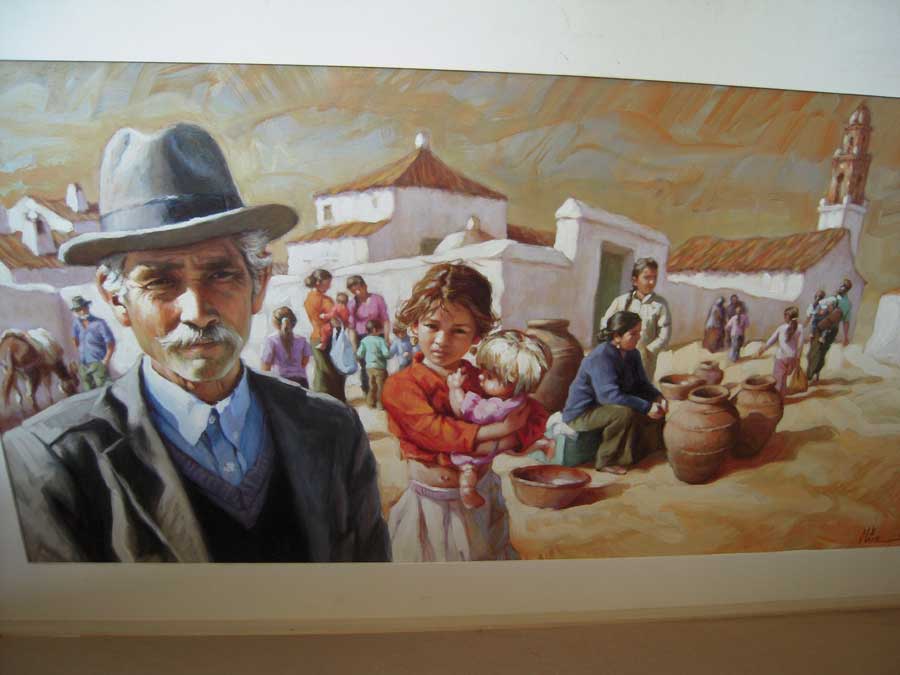
R: I paint figurative art and some say impressionism art. It is important that you feel what I feel when you look at my paintings, the look in a person’s eyes, a look that goes far beyond, deep into their soul, my art is about sentiments and emotions and my objective is to portray just that.
M:Have you already started on your next collection / theme or is it too soon to ask?
R: Let’s say the next collection will have something to do with windows and when it’s nearing completion I will give you a call Michael to have a peek.
M: As always Rafael it`s an education talking to you and I look forward to seeing the next collection.
R: My pleasure, talk to you soon.
Interviews can go either way, you can end up getting more or less what you expected from your prepared questions while on numerous occasions a relatively simple question can take you on a journey that is a story in itself.
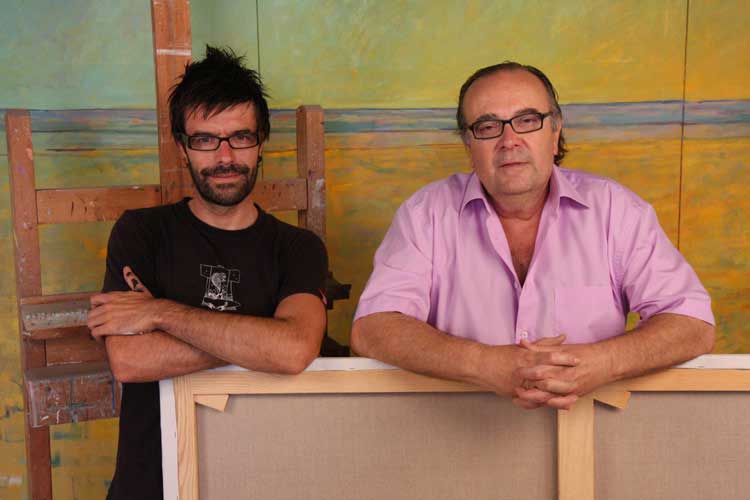 In August 2009, I was going to interview Florencio Aguilera and his son Chencho but with the papers (Costa de la Luz Resident) tight deadline and the hugely successful Aguilera exhibition in Ayamonte the opportunity passed. However as a very good friend of mine says “What was meant for you, won’t go past you” and I hope you the reader enjoy this interview as I certainly did.
In August 2009, I was going to interview Florencio Aguilera and his son Chencho but with the papers (Costa de la Luz Resident) tight deadline and the hugely successful Aguilera exhibition in Ayamonte the opportunity passed. However as a very good friend of mine says “What was meant for you, won’t go past you” and I hope you the reader enjoy this interview as I certainly did.
For those of you unfamiliar with Ayamonte, the Florencio Aguilera studio is in Plaza de San Francisco and it is part of the building that is the Marques de Ayamonte Palace. It was here I met two generations of the Aguilera family both painters on a cloudy January afternoon in 2010.
The palace is enormous with an internal patio that I had heard about but never actually visited until this interview and it was Chencho, Florencio’s second son, who gave me a guided tour of what will be the an exhibition area which will be opened to the public from July to September. The exhibition will be of three generations of the Aguilera family: Rafael Aguilera, Florencio Aguilera and Chencho effectively capturing the history of Ayamonte and surrounds from 1903 to present day.
Chencho Aguilera at 34 is the third generation of painters in the Aguilera family and he is the first to sit down in front of the log fire to answer my questions.
M: Thank you for inviting us to your home and studio, I have to say I am amazed at the amount of art and space you have here. Can I ask you when you painted your first painting?
C: I was about four and painted it along with my father in this very house.
M: I notice you say house, both your father and you have your studios here, what was it like growing up having a famous artist as a dad and living in this huge house?
M: Fantastic, I am lucky to have the support of my family and to be able to paint my style of paintings which are very different from my father’s. My father has taught me a lot and I also studied Bella Artes in Seville. I paint imaginative art and my father paints figurative abstract art so we are very different in our styles which is good as you can’t really compare.
M: There must be some similarities?
C: We are quite different in lots of things, I am anti-taurino but my dad was a bullfighter in charity bull fights and still loves bullfighting. I love alternative rock like Sound Garden and Ben Harper while my dad likes classical music. Having said that, we both need to have music playing to paint.
M: I also heard that you have painted some surfboards and also saw a video of you on youtube making your very own, so you are a surfer in your free time?
C: The surfboards is also a type of painting I like, using an airbrush to create unique surfboards. As for making my own surfboard it was actually a kitesurfing board that I helped with and painted.
M: More kitesurfing in Ayamonte than surfing, I did notice that you signed the board as “Niño Tiburon” baby shark, what is that about?
C: Yes, for the art I do on surfboard and kitesurfboards I go under that name.
M: So Chencho are you more at home on the beach or painting in your studio?
C: Ideal situation would be painting on the beach with the surfboard at hand whenever I need it.
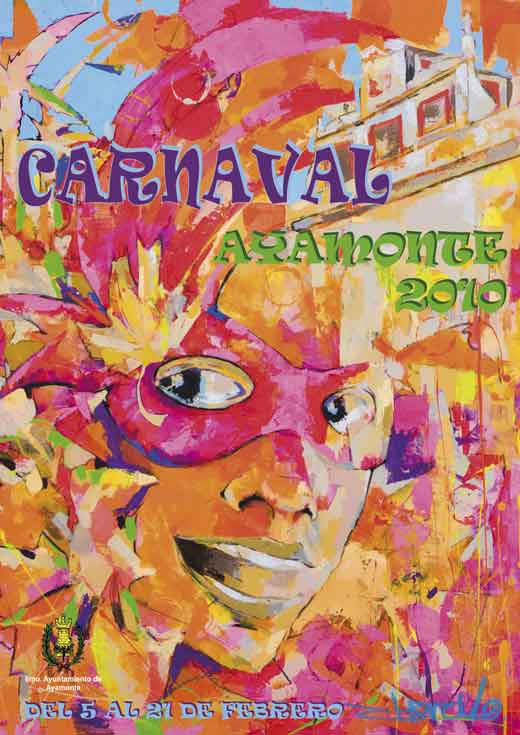 M: You have painted the poster for Ayamonte’s 2010 Carnival, how did that come about?
M: You have painted the poster for Ayamonte’s 2010 Carnival, how did that come about?
C: The Ayamonte town hall Cultural department were at the exhibition we had in August 2009 and I think what they saw there led them to commission me for the poster.
M: It is difficult to become an artist or should I say make a living painting?
C: Like I said, I was lucky to have the support and materials around me from a very early age but I think if you are sincere, honest and dedicated to your art, you will succeed. It is very risky to dedicate all your time and future to painting but if you have a group of people who appreciate what you do and you can project your emotions from a painting to the person who is looking at that painting you have a very good chance at succeeding.
M: Thank you Chencho, I look forward to seeing your next exhibition.
C: A pleasure and I look forward to seeing you and your readers at the exhibition.
Florencio Aguilera walks into the room and asks permission to light up a cigar during the interview. To which I say if a man in his own home can’t smoke a cigar in peace we are in trouble.
M: I can’t help but notice all the paintings you have of bulls, bullfighters and bull rings and even your cigar would fit into an evening of bullfighting.
F: I have a few passions in life, art, music and bullfighting. I took part in 15 charity bullfights myself and I think to paint anything belonging to this art you must have hands on experience.
M: Did you ever get caught by the bull?
F: Of course, broken bones and dislocated shoulders were the marks they left behind but the experience of putting yourself in front of a bull is a singular experience.
M: This year you will celebrate 50 years as an artist with the biggest exhibition ever, tell me something about it.
 F: My father Rafael was the first painter in my family and although painting was not his only source of income, he painted numerous works of art. My son Chencho now has a formidable amount of art and what better way to celebrate 50 years as an artist’s surrounded by family.
F: My father Rafael was the first painter in my family and although painting was not his only source of income, he painted numerous works of art. My son Chencho now has a formidable amount of art and what better way to celebrate 50 years as an artist’s surrounded by family.
M: Your father Rafael was more prolific in his later years.
F: My dad at 80 said that he was going to start painting seriously and he continued for 15 more years painting what I would say is the history of Ayamonte as he saw it in the 20th century. I even have his last unfinished painting that he started days before his death in 1998 at the age of 95.
M: You are a self-taught and you have done very well if you don’t mind me saying.
F: Yes, but studies and a career are important and I say this to Chencho.
M: I can see you are very proud of your father and indeed your son Chencho but I have got to ask who the best painter is.
F: Do you know what, I think my son and my dad are better painters than me.
M: I know you are a great lover of music and the international music festival had your patio as one of the venues in 2003. Unluckily for me I missed the concerts but will you open up the Palace and patio again to concerts?
F: Music is above everything and I think you can live all the good things in life through music. As for the concerts, they return again this year and all I can say at this stage is that there will be at least 2 concerts held here. It will be something really special.
M: You have numerous paintings of places all over Europe and many are landscapes here in Ayamonte, some in Tavira others up along the Guadiana river. Do you have any place that stands out for you in particular?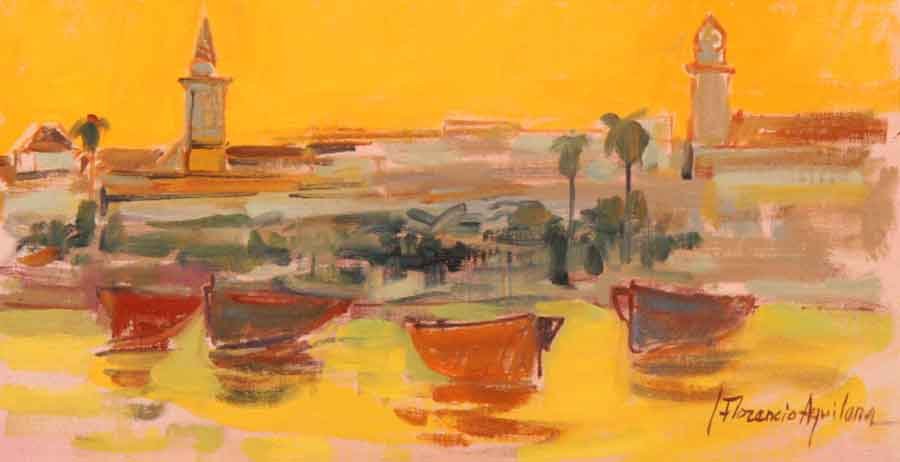
F: There are places that are special at times and right now I spend a lot of time in Pulo do Lobo, in Portugal where there is a waterfall on the Guadiana, I do a lot of painting up there and to be honest I like painting along the Algarve coast.
M: When I first arrived in this area of Costa de la Luz, I couldn’t help noticing that landscapes looked clearer or brighter, do you think the light is special here.
F: Ayamonte is where I was born and I was lucky to have this special type of light to paint but the soul of an artist will always adapt to their circumstances and surroundings when they paint.
M: You have travelled a lot over the years has this helped in your painting?
F: I love that there is different atmospheres in different areas and I adapt relatively quickly to the cities I visit. Different cultures, different music and a different atmosphere they are all an education.
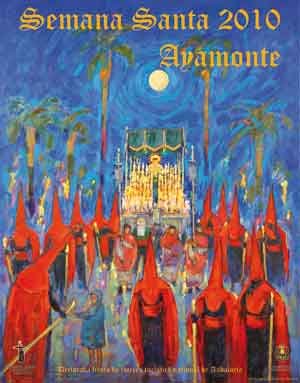 M: You are also painting the Poster for Ayamonte’s Easter week (2010).
M: You are also painting the Poster for Ayamonte’s Easter week (2010).
F: Yes, my father was the founding member of the brotherhood Sangrado Lanzado en 1918 and this year (2010) it is their turn to paint the poster so I offered to do it.
M: So Easter week is a special time for you?
F: Semana Santa has its own beauty, the costaleros, the thrones so it is a special time.
M: Thank you for taking some time out to speak to Infoayamonte.
F: You are welcome and I invite all your readers to visit our next exhibition.
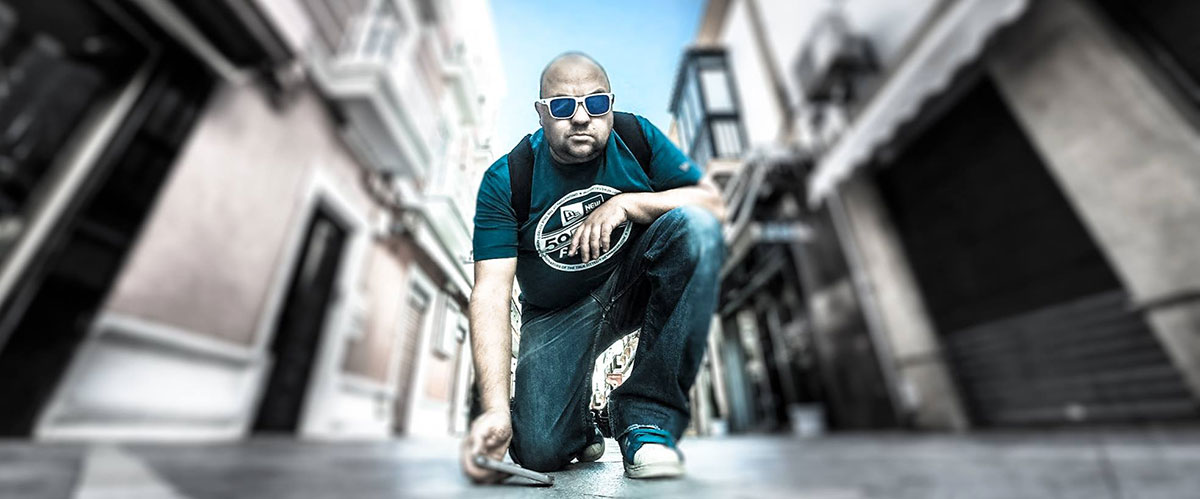









 Ayamonte has charmed its fair share of artists over the last century and Sorrolla’s “La pesca de atún”, tuna fishing, depicting sailors landing tuna on the banks of the Guadiana River, is probably one of the best known paintings to have come out of this border town. It seems only fitting that we talk to a son of a sailor and one of the most famous present day artists in Ayamonte, Rafael Oliva.
Ayamonte has charmed its fair share of artists over the last century and Sorrolla’s “La pesca de atún”, tuna fishing, depicting sailors landing tuna on the banks of the Guadiana River, is probably one of the best known paintings to have come out of this border town. It seems only fitting that we talk to a son of a sailor and one of the most famous present day artists in Ayamonte, Rafael Oliva.



 In August 2009, I was going to interview Florencio Aguilera and his son Chencho but with the papers (Costa de la Luz Resident) tight deadline and the hugely successful Aguilera exhibition in Ayamonte the opportunity passed. However as a very good friend of mine says “What was meant for you, won’t go past you” and I hope you the reader enjoy this interview as I certainly did.
In August 2009, I was going to interview Florencio Aguilera and his son Chencho but with the papers (Costa de la Luz Resident) tight deadline and the hugely successful Aguilera exhibition in Ayamonte the opportunity passed. However as a very good friend of mine says “What was meant for you, won’t go past you” and I hope you the reader enjoy this interview as I certainly did.
 M: You have painted the poster for Ayamonte’s 2010 Carnival, how did that come about?
M: You have painted the poster for Ayamonte’s 2010 Carnival, how did that come about? F: My father Rafael was the first painter in my family and although painting was not his only source of income, he painted numerous works of art. My son Chencho now has a formidable amount of art and what better way to celebrate 50 years as an artist’s surrounded by family.
F: My father Rafael was the first painter in my family and although painting was not his only source of income, he painted numerous works of art. My son Chencho now has a formidable amount of art and what better way to celebrate 50 years as an artist’s surrounded by family.
 M: You are also painting the Poster for Ayamonte’s Easter week (2010).
M: You are also painting the Poster for Ayamonte’s Easter week (2010).